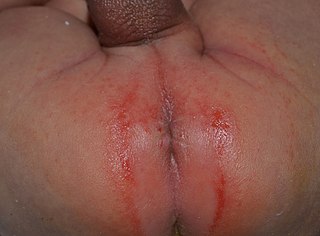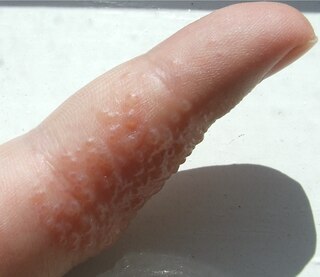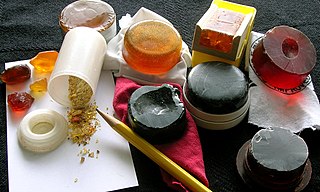Related Research Articles

Dermatitis is a group of diseases that result in inflammation of the skin. These diseases are characterized by itchiness, red skin and a rash. In cases of short duration, there may be small blisters, while in long-term cases the skin may become thickened. The area of skin involved can vary from small to covering the entire body.

Irritant diaper dermatitis is a generic term applied to skin rashes in the diaper area that are caused by various skin disorders and/or irritants.

Contact dermatitis is a type of inflammation of the skin.
Stasis dermatitis refers to the skin changes that occur in the leg as a result of "stasis" or blood pooling from insufficient venous return; the alternative name of varicose eczema comes from a common cause of this being varicose veins.
An occupational disease is any chronic ailment that occurs as a result of work or occupational activity. It is an aspect of occupational safety and health. An occupational disease is typically identified when it is shown that it is more prevalent in a given body of workers than in the general population, or in other worker populations. The first such disease to be recognised, squamous-cell carcinoma of the scrotum, was identified in chimney sweep boys by Sir Percival Pott in 1775. Occupational hazards that are of a traumatic nature are not considered to be occupational diseases.

Dyshidrosis is a type of dermatitis that is characterized by itchy blisters on the palms of the hands and bottoms of the feet. Blisters are generally one to two millimeters in size and heal over three weeks. However, they often recur. Redness is not usually present. Repeated attacks may result in fissures and skin thickening.

Erythroderma is an inflammatory skin disease with redness and scaling that affects nearly the entire cutaneous surface. This term applies when 90% or more of the skin is affected.

Perioral dermatitis, also known as periorificial dermatitis, is a common type of skin rash. Symptoms include multiple small (1–2 mm) bumps and blisters sometimes with background redness and scale, localized to the skin around the mouth and nostrils. Less commonly the eyes and genitalia may be involved. It can be persistent or recurring and resembles particularly rosacea and to some extent acne and allergic dermatitis. The term "dermatitis" is a misnomer because this is not an eczematous process.

Phacelia is a genus of about 200 species of annual or perennial herbaceous plants, native to North and South America. California is particularly rich in species with over 90 recorded in the region.

Tetrazepam is a benzodiazepine derivative with anticonvulsant, anxiolytic, muscle relaxant and slightly hypnotic properties. It was formerly used mainly in Austria, France, Belgium, Germany and Spain to treat muscle spasm, anxiety disorders such as panic attacks, or more rarely to treat depression, premenstrual syndrome or agoraphobia. Tetrazepam has relatively little sedative effect at low doses while still producing useful muscle relaxation and anxiety relief. The Co-ordination Group for Mutual Recognition and Decentralised Procedures-Human endorsed the Pharmacovigilance Risk Assessment Committee (PRAC) recommendation to suspend the marketing authorisations of tetrazepam-containing medicines across the European Union (EU) in April 2013. The European Commission has confirmed the suspension of the marketing authorisations for Tetrazepam in Europe because of cutaneous toxicity, effective from the 1 August 2013.

Cheilitis is a medical condition characterized by inflammation of the lips. According to its onset and course, cheilitis can be either acute or chronic. Most cheilitis is caused by acute sun exposure. Allergic tests may identify allergens that cause cheilitis.
Id reactions are types of acute dermatitis developing after days or weeks at skin locations distant from the initial inflammatory or infectious site. They can be localised or generalised. This is also known as an 'autoeczematous response' and there must be an identifiable initial inflammatory or infectious skin problem which leads to the generalised eczema. Often intensely itchy, the red papules and pustules can also be associated with blisters and scales and are always remote from the primary lesion. It is most commonly a blistering rash with itchy vesicles on the sides of fingers and feet as a reaction to fungal infection on the feet, athlete's foot. Stasis dermatitis, allergic contact dermatitis, acute irritant contact eczema and infective dermatitis have been documented as possible triggers, but the exact cause and mechanism is not fully understood. Several other types of id reactions exist including erythema nodosum, erythema multiforme, Sweet's syndrome and urticaria.

Chlorproethazine, sold under the brand name Neuriplege, is a drug of the phenothiazine group described as a muscle relaxant or tranquilizer which is or has been marketed in Europe as a topical cream for the treatment of muscle pain. It has been associated with photoallergic contact dermatitis.
Airbag dermatitis is caused skin irritation and trauma secondary to the deployment of airbags.

Abietic acid dermatitis is a contact dermatitis often seen in association with musical instruments.

Paederus dermatitis, medically known as dermatitis linearis, is a skin irritation resulting from contact with the hemolymph of certain rove beetles, a group that belongs to the insect order Coleoptera and the genus Paederus. Other local names given to Paederus dermatitis include spider-lick, whiplash dermatitis, and Nairobi fly dermatitis.
Tulip fingers are a cutaneous condition, a combined allergic and irritant contact dermatitis caused by contact with tulip bulbs.
Protein contact dermatitis is a cutaneous condition, and was a term originally used to describe an eczematous reaction to protein-containing material in food handlers.

Poison ivy is an allergenic plant in the genus Toxicodendron native to Asia and North America. It is well known for causing urushiol-induced contact dermatitis, an itchy, irritating, and sometimes painful rash, in most people who touch it. The rash is caused by urushiol, a clear liquid compound in the plant's sap. The plant is variable in its appearance and habit, and despite its common name, it is not a true ivy (Hedera), but rather a member of the cashew and pistachio family (Anacardiaceae). T. radicans is commonly eaten by many animals, and the seeds are consumed by birds, but poison ivy is most often thought of as an unwelcome weed. Poison ivy was formerly treated as a single species, Toxicodendron radicans, but is now generally treated as a complex of three separate species: Toxicodendron radicans, Toxicodendron rydbergii and Toxicodendron orientale.

Paederus is a genus of small beetles of the family Staphylinidae. With 622 valid species assigned by 1987 to the subtribe Paederina, and with all but 148 within Paederus itself, the genus is large. Due to toxins in the hemolymph of some species within this genus, it has given its name to paederus dermatitis, a characteristic skin irritation that occurs if one of the insects is crushed against skin. That name, Paederus dermatitis, is a poor choice because, decades earlier, the affliction had been called dermatitis linearis, a name that works in all languages, not just English, because of its Latin origin; the name Paederus dermatitis is also inappropriate because it has shown to be caused by (a) only a few species of the genus Paederus, but (b) also a few species that belong to closely related genera within the subtribe Paederina. A scholarly paper in 2002 suggested that a Paederus species could have been responsible for some of the ten Plagues of Egypt described in the Bible's Book of Exodus.
References
- ↑ Rapini, Ronald P.; Bolognia, Jean L.; Jorizzo, Joseph L. (2007). Dermatology: 2-Volume Set. St. Louis: Mosby. p. 1374. ISBN 978-1-4160-2999-1.
| This cutaneous condition article is a stub. You can help Wikipedia by expanding it. |